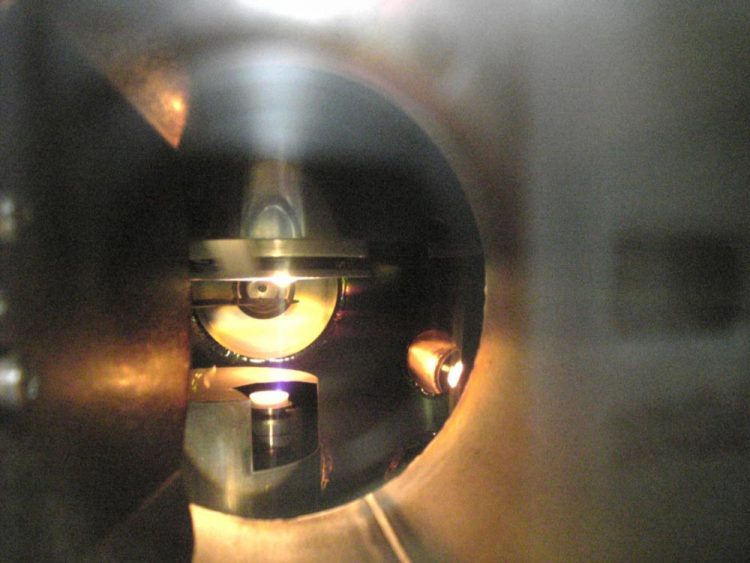The future of semiconductors is clear

A focused laser is used to create thin films of tin dioxide. Credit: © 2020 Nakao et al.
Mobility is a key parameter for semiconductor performance and relates to how quickly and easily electrons can move inside a substance. Researchers have achieved the highest mobility among thin films of tin dioxide ever reported. This high mobility could allow engineers to create thin and even transparent tin dioxide semiconductors for use in next-generation LED lights, photovoltaic solar panels or touch-sensitive display technologies.
Tin and oxygen are very familiar elements, and when combined in a certain way to become tin dioxide, the material can be made into a semiconductor. Semiconductors are fundamental to most of our technology and are the basis of computer chips, solar panels and more. Since the 1960s, tin dioxide specifically has found use in industrial applications like gas sensors and transparent electrodes for solar devices. The material is effective for these things because of its high mobility. For most applications, higher is better. However, the high mobility of tin oxide only existed in large bulk crystals, until now.
“We demonstrated the highest mobility in a thin film of tin oxide ever achieved. Improved mobility not only enhances the conductivity but also the transparency of the material,” said Shoichiro Nakao, a researcher from the Department of Chemistry at the University of Tokyo. “Generally, transparency and conductivity cannot coexist in a material. Typical transparent materials such as glass or plastic are insulating, whereas conducting materials like metals are opaque. Few materials exhibit transparent conductivity — it's very interesting!”
The more transparent a semiconductor can be, the more light it can let through. Nakao and his team have made a tin oxide thin film that allows visible light and near-infrared light to pass. This is a great benefit to the power conversion efficiency of photovoltaic solar panels, but other uses could include enhanced touch-screen displays with even better accuracy and responsiveness, or more efficient LED lights.
“Our method of production was key to creating a substance with these properties. We used a highly focused laser to evaporate pellets of pure tin dioxide and deposit or grow material exactly how we wanted it,” said Nakao. “Such a process allows us to explore different growth conditions as well as how to incorporate additional substances. This means we can endow tin dioxide semiconductors with high mobility and useful functionality.”
###
Journal article
Michitaka Fukumoto, Shoichiro Nakao, Kei Shigematsu, Daisuke Ogawa, Kazuo Morikawa, Yasushi Hirose, and Tetsuya Hasegawa. High mobility approaching the intrinsic limit in Ta-doped SnO2 films epitaxially grown on TiO2 (001) substrates. Scientific Reports.
DOI: 10.1038/s41598-020-63800-3
Funding and support
This work was supported by JSPS KAKENHI Grant Number 15K04687 and CREST, JST.
Useful links
Solid State Chemistry Laboratory – http://www.
Department of Chemistry – https:/
Graduate School of Science – https:/
Related article – https:/
Research contact
Dr. Shoichiro Nakao
Department of Chemistry, The University of Tokyo,
7-3-1 Hongo, Bunkyo-ku, 113-0033 Tokyo, Japan
Tel: +81-(0)3-5841-4354
Email: nakao@chem.s.u-tokyo.ac.jp
Press Contacts
Mr. Rohan Mehra
Division for Strategic Public Relations, The University of Tokyo
7-3-1 Hongo, Bunkyo-ku, Tokyo 113-8654, JAPAN
Tel: +81-(0)80-9707-8450
Email: press-releases.adm@gs.mail.u-tokyo.ac.jp
About the University of Tokyo
The University of Tokyo is Japan's leading university and one of the world's top research universities. The vast research output of some 6,000 researchers is published in the world's top journals across the arts and sciences. Our vibrant student body of around 15,000 undergraduate and 15,000 graduate students includes over 4,000 international students. Find out more at http://www.
Media Contact
All latest news from the category: Power and Electrical Engineering
This topic covers issues related to energy generation, conversion, transportation and consumption and how the industry is addressing the challenge of energy efficiency in general.
innovations-report provides in-depth and informative reports and articles on subjects ranging from wind energy, fuel cell technology, solar energy, geothermal energy, petroleum, gas, nuclear engineering, alternative energy and energy efficiency to fusion, hydrogen and superconductor technologies.
Newest articles

First-of-its-kind study uses remote sensing to monitor plastic debris in rivers and lakes
Remote sensing creates a cost-effective solution to monitoring plastic pollution. A first-of-its-kind study from researchers at the University of Minnesota Twin Cities shows how remote sensing can help monitor and…

Laser-based artificial neuron mimics nerve cell functions at lightning speed
With a processing speed a billion times faster than nature, chip-based laser neuron could help advance AI tasks such as pattern recognition and sequence prediction. Researchers have developed a laser-based…

Optimising the processing of plastic waste
Just one look in the yellow bin reveals a colourful jumble of different types of plastic. However, the purer and more uniform plastic waste is, the easier it is to…



